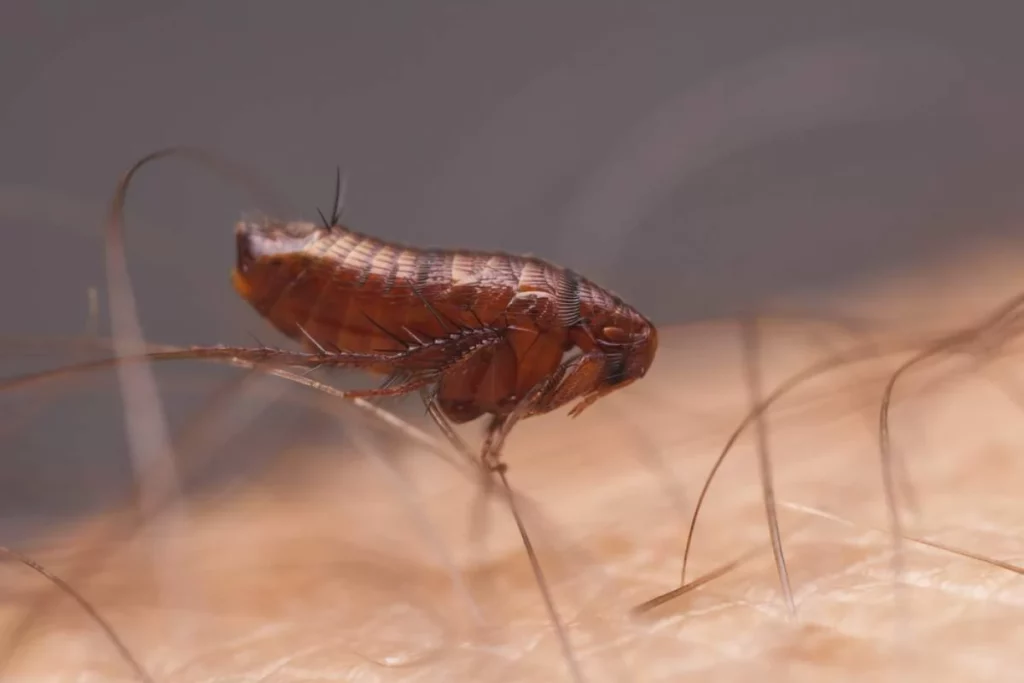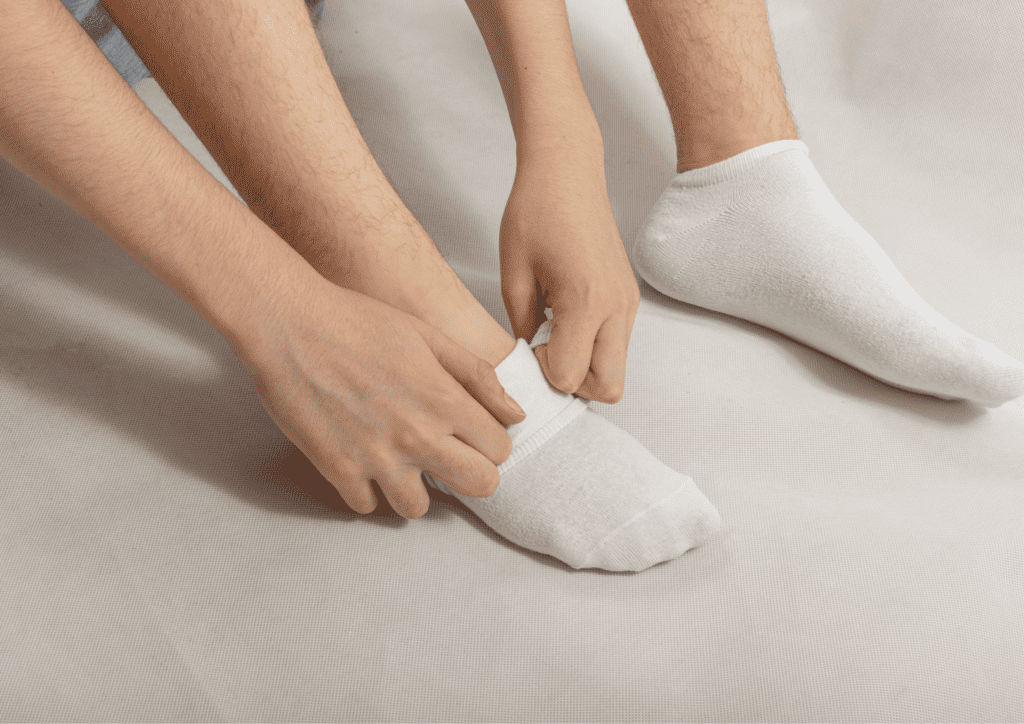Fleas are a common problem that many homeowners and pet owners face. These small, annoying pests can cause discomfort, allergies, and even diseases in humans and animals alike. To effectively control and prevent fleas, it is crucial to understand their origins, nature, and how they infest homes and yards. In this article, we will cover the causes of fleas, their connection to animals, and their effects on the environment.
POINTS
- Flea infestations can develop rapidly due to their quick reproduction rate, laying up to 50 eggs per day that can hatch in as little as two days.
- Pets, particularly dogs and cats, are often the primary cause of flea infestations in homes, but fleas can also enter homes through humans or wild animals.
- The flea life cycle consists of four stages (egg, larva, pupa, and adult) and understanding this cycle is essential for controlling and preventing infestations.
- Flea infestations can lead to various health issues and discomfort for both humans and pets, including skin irritation, flea allergy dermatitis, anemia, and disease transmission.
- To prevent future flea infestations, regular pet treatments with veterinarian-recommended preventatives, maintaining a clean home and yard, and sealing gaps in your home’s foundation are crucial measures.
Understanding Fleas: Their Origin and Nature
Where do fleas come from originally?

Fleas are small, wingless insects that belong to the order Siphonaptera. These parasites have been around for millions of years, with fossil evidence dating back to the Jurassic period. Fleas are believed to have evolved from ancestors that fed on the blood of reptiles and eventually adapted to feeding on warm-blooded animals like mammals and birds.
Are fleas visible to the human eye? Are flea eggs visible?

Fleas are usually visible to the human eye, but their small size (around 1/8 inch long) and quick movements may make them hard to spot. They are typically dark brown or reddish-brown in color. Flea eggs, on the other hand, are much smaller, white or transparent, and more difficult to see with the naked eye.
How do fleas find hosts or prey?
Fleas detect their hosts through a combination of factors, including body heat, vibrations, carbon dioxide, and odors emitted by the host. Once a flea senses a potential host nearby, it will jump onto the host to feed on its blood. Fleas have specialized mouthparts designed for piercing the skin and sucking blood, ensuring their survival and reproduction.
The Connection between Fleas and Animals
Do mice have fleas? Can mice bring fleas into the house?

Yes, mice can have fleas. In fact, fleas are a common parasite on many wild rodents like mice, rats, and squirrels. If these rodents find their way into your home, they may inadvertently introduce fleas into the environment, leading to infestations.
Can humans carry fleas from one house to another?

Although fleas prefer to feed on animals, they can also bite humans and hitch a ride on clothing or belongings. This means it is possible for a person to unknowingly carry fleas from an infested location to a new environment.
Can other animals or pets bring fleas into the house?

Pets, particularly dogs and cats, are often the primary culprits for introducing fleas into a home. Fleas can easily jump onto your pet while it is outside and then be brought inside when the pet reenters the house. Additionally, wild animals like raccoons, opossums, and birds can bring fleas into your yard or even indoors if they find access to your home.
The Phenomenon of Flea Infestation in Homes
What causes fleas in the house?
Fleas in the house typically come from animals, whether they are your pets or wild animals that have found their way inside. Fleas can also be carried into the home by humans unknowingly, on clothing, shoes, or personal belongings. The warm, humid environment within a house provides ideal conditions for fleas to thrive and reproduce.
How do fleas get in the house? What are the different ways fleas can enter a house?
Understanding how fleas enter homes is crucial for preventing infestations and protecting both your family and pets. Below is a table summarizing the various methods through which fleas can find their way into your home, along with preventive strategies to block these entry points.
| Entry Method | Description | Preventive Strategies |
|---|---|---|
| Carried in on pets | Pets can bring fleas into the home after being outside. | Regularly treat pets with veterinarian-recommended flea preventatives. |
| Hitching a ride on humans | Fleas can attach themselves to clothing or personal items. | Change and wash clothes immediately if you’ve been in an infested area. |
| Through open doors, windows, or cracks | Fleas enter through small openings in the home’s exterior. | Seal gaps and cracks; install screens on windows and doors. |
| On wild animals | Wild animals carrying fleas can enter homes or bring them into the yard. | Secure trash and close off entry points to prevent wild animals from entering. |
Can fleas infest a house without pets?
Yes, fleas can infest a house without pets. While pets are the most common source of flea infestations in homes, it is still possible for fleas to find their way indoors through other means, such as wild animals or humans carrying them unknowingly.
How quickly can fleas infest a house?
Flea infestations can develop quickly due to their rapid reproduction rate. A single female flea can lay up to 50 eggs per day, which can hatch in as little as two days. As a result, it’s possible for a small number of fleas to lead to a significant infestation within a matter of weeks if left untreated.
How do you know if you have a flea infestation in your house?
Recognizing the early signs of a flea infestation is essential for taking swift action to control and eliminate the problem before it worsens. Here’s a table that outlines the key indicators of flea activity in your home, along with recommended actions if these signs are observed.
| Sign of Infestation | Description | Recommended Action |
|---|---|---|
| Seeing fleas or flea eggs | Actual sightings of fleas or their tiny, white eggs on pets or around the home. | Use a flea comb on pets, vacuum thoroughly, and consult a veterinarian for flea treatments. |
| Pets excessively scratching | Pets scratching more than usual, indicating discomfort from flea bites. | Check pets for fleas and flea dirt; consider flea preventative treatments. |
| Sudden onset of flea allergy dermatitis | Pets showing signs of allergic reactions to flea bites, such as severe itching or skin lesions. | Visit a veterinarian for diagnosis and treatment; clean home and pet areas thoroughly. |
| Red, itchy bites on humans | Family members experiencing small, itchy bites, often around ankles or legs. | Use anti-itch creams and ensure all pets and home areas are treated for fleas. |
| Flea dirt | Tiny black specks (flea feces) in pet fur or on surfaces around the home. | Vacuum and wash all bedding and soft furnishings; treat pets with recommended flea control products. |
Understanding the Flea Life Cycle and Infestation Progression
What constitutes a flea infestation? How many fleas is an infestation?

A flea infestation is characterized by the presence of a significant number of fleas in your home or on your pets, causing nuisance and potential health issues for both animals and humans. Even a small number of fleas can quickly multiply and become an infestation due to their rapid reproductive rate.
What are flea egg sacs and what role do they play in infestations?
Flea egg sacs are not technically sacs; female fleas lay individual eggs after feeding on a host. These eggs are oval, white, and very small, making them difficult to see. Flea eggs play a crucial role in infestations, as they can be laid in various locations throughout your home or yard, leading to a large, widespread population of fleas as they hatch and grow.

What stages does a flea infestation go through?
A flea infestation progresses through four stages: egg, larva, pupa, and adult.
- Eggs: Female fleas lay eggs shortly after feeding. These eggs can be found in many locations, including carpets, upholstery, and pet bedding.
- Larva: Flea eggs hatch into larvae, which resemble tiny, white worms. The larvae feed on organic debris, including flea feces (flea dirt), and avoid light, often hiding in cracks or under furniture.
- Pupa: The larval stage is succeeded by the pupal stage, during which the flea undergoes metamorphosis within a protective silk cocoon. Pupae can remain dormant for weeks to months, waiting for the right conditions to emerge as adults.
- Adult: Adult fleas emerge from their pupal stage and seek a host, beginning the cycle anew. Adults are the biting and reproducing members of the population.
Fleas in the Yard and Outdoor Environments
What causes fleas in the yard?

Fleas in your yard can come from various sources, including infested pets, wild animals, or neighboring properties. Fleas thrive in moist, shady areas, so keep your yard well-maintained and free of debris to deter them.
Why do I have fleas in my yard?
You may have fleas in your yard for several reasons, including:
- Infested pets spending time outdoors, dropping flea eggs and encouraging flea populations to grow
- Wild animals like rodents, raccoons, or opossums carrying fleas into your yard
- Fleas migrating from neighboring yards or environments
- Overgrown grass, bushes, or piles of leaves, providing ideal hiding spots and breeding grounds for fleas
Are there specific types of fleas, like tree fleas, that infest outdoor environments?
While there isn’t a specific “tree flea” species, some flea species are more common in outdoor environments. For example, the common cat flea (Ctenocephalides felis) is known to infest both indoor and outdoor spaces. To reduce the risk of flea infestations outdoors, maintain a clean and tidy yard, trim tall grass and bushes, and ensure your pets are treated with flea preventatives.
The Impact of Fleas and Flea Infestations
What problems can a flea infestation cause?
Flea infestations can lead to various issues, including:
| Health Risk | Symptoms in Humans | Symptoms in Pets | Prevention Tips |
|---|---|---|---|
| Skin irritation and itching | Red, itchy bites, often around ankles | Excessive scratching, biting, or licking | Regular flea treatment for pets; vacuum regularly. |
| Flea allergy dermatitis (FAD) | Not typically applicable to humans | Skin redness, hair loss, lesions | Consult a vet for treatment; maintain flea control. |
| Anemia | Fatigue, pallor (in severe cases) | Weakness, pale gums, lethargy | Treat and prevent fleas; monitor for heavy infestations. |
| Disease transmission | Cat scratch disease, murine typhus | Tapeworms, Bartonellosis | Use flea preventatives; keep pets indoors as possible. |
- Skin irritation, itching, and redness in humans and pets due to flea bites
- Flea allergy dermatitis, a skin reaction in pets sensitive to flea saliva
- Anemia, especially in young or small animals, due to blood loss from multiple flea bites
- Transmission of diseases and parasites, such as tapeworms, cat scratch disease, and murine typhus
What to do about a flea infestation in the house?
If you have a flea infestation in your home, take the following steps:
- Treat your pets with veterinarian-approved flea preventatives, shampoos, or medications.
- Thoroughly vacuum your entire home, including carpets, upholstery, and pet bedding, to remove eggs, larvae, and pupae. Dispose of the vacuum contents immediately in an outdoor trash receptacle.
- Wash pet bedding, plush toys, and any other washable items in hot water.
- Use chemical treatments, like insect growth regulators (IGRs) or flea sprays, to treat the infested areas, or enlist the help of a professional pest control service.
- Monitor the situation closely and repeat treatments if necessary.
Are there specific periods or conditions when most flea infestations take place?
Flea infestations are more common during warmer, humid months, as these conditions promote the growth and reproduction of fleas. However, fleas can survive and reproduce indoors during colder months, making it essential to remain vigilant year-round.
Potential Remedies for Fleas and Flea Infestations
When it comes to tackling flea infestations, homeowners often weigh the benefits of home remedies against professional treatments. The table below compares these two approaches, providing insights into their effectiveness, cost, and suitability for different situations.
| Treatment Approach | Description | Effectiveness | Cost | Best Used For |
|---|---|---|---|---|
| Home Remedies | Natural or DIY solutions like diatomaceous earth, flea traps, and essential oils. | Varies; some are effective as preventive measures. | Generally low; materials are often readily available at home or in stores. | Mild infestations, preventive measures, and ongoing maintenance in conjunction with professional treatments. |
| Professional Treatments | Services provided by pest control professionals, including chemical treatments and fumigation. | High; designed to target and eliminate infestations quickly. | Higher; depends on the extent of infestation and treatment type. | Severe infestations, when home remedies fail, and for those seeking comprehensive, immediate solutions. |
Can I use tea tree oil for fleas on furniture?
While tea tree oil has been touted as a natural remedy for fleas, it can be harmful to your pets if ingested or applied directly to their skin. Instead, consider using alternative flea treatments, such as diatomaceous earth, which is safer for pets and effective against fleas.
What are some other potential solutions for flea infestations in the home?
Some other potential solutions to eliminate fleas in the home include:
- Vacuuming your home frequently
- Using flea traps, which lure flea adults with heat and light, trapping them on sticky surfaces
- Applying chemical treatments, such as insecticides or flea powders, to carpets and other infested areas
- Consulting with a pest control professional for more extensive infestations
Recognizing and Managing Flea Infestations
Effective flea control involves a comprehensive approach that targets fleas at every stage of their life cycle. Here’s a checklist table to help you stay organized and ensure that you’re taking all necessary steps to prevent and manage flea infestations in your home and on your pets.
| Task | Description | Done (✓/✕) |
|---|---|---|
| Vacuuming | Thoroughly vacuum floors, carpets, and furniture, especially in areas where pets spend time. | |
| Pet Treatment | Treat pets with veterinarian-recommended flea preventatives. | |
| Wash Bedding | Wash all pet and human bedding in hot water to kill fleas and eggs. | |
| Yard Maintenance | Keep the yard trimmed and clear of debris to reduce flea habitats. | |
| Seal Entry Points | Check and seal any gaps or cracks in the home’s exterior to prevent fleas from entering. | |
| Flea Traps | Set up flea traps around the home to monitor and reduce adult flea populations. | |
| Professional Pest Control Consultation | Consult a pest control professional if the infestation persists or for preventive advice. |
How can one recognize a flea problem in the house?
To recognize a flea problem in your house, keep an eye out for the following signs:
- Observed fleas crawling on surfaces, pets, or yourself
- Pets exhibiting excessive scratching, grooming, or restlessness
- Unexplained small, red, itchy bites on your skin
- Black or reddish specks (flea dirt) on pet bedding, carpets, or upholstered furniture
What steps should be taken if a room is infested with fleas?

If you suspect a flea infestation in a particular room:
- Thoroughly vacuum the room, including carpets, furniture, and any pet bedding. Make sure to dispose of the vacuum contents promptly in an outdoor trash receptacle.
- Wash any washable items, such as pet bedding, in hot water.
- Apply a flea treatment, such as an insect growth regulator, flea powder, or spray, to the affected areas according to the product’s instructions.
- Monitor the infestation closely and repeat treatments as necessary.
- Seek professional help from a pest control expert if the infestation persists or worsens.
How to find fleas in the house if suspected of an infestation?
To find fleas in your home, follow these tips:
- Use a flea comb on your pets to check for adult fleas, eggs, or flea dirt.
- Inspect your carpets, upholstery, and pet bedding for flea dirt, eggs, or live fleas.
- Set up flea traps near suspected infestation areas to attract and capture adult fleas.
- Wear white socks and walk slowly across areas where you suspect fleas may be present. This will make it easier to spot fleas or flea dirt that cling to your socks.

Myths and Misconceptions about Fleas
Do fleas fly?
Fleas do not fly. They are wingless insects that rely on their powerful hind legs to jump great distances relative to their size, which allows them to quickly move between hosts and environments.
Can humans carry fleas from one house to another?
While fleas prefer to infest animals, they can temporarily attach themselves to humans, hitching a ride on clothes, shoes, or personal belongings. Although it is less common, humans can unwittingly transport fleas from one location to another.
Are there different types of fleas, like “box fleas” or “fruit valley vet oswego”?
There are over 2,000 species of fleas, but most infestations in homes or on pets are caused by the cat flea (Ctenocephalides felis) or the dog flea (Ctenocephalides canis). The terms “box fleas” and “fruit valley vet oswego” do not refer to actual flea species, and may simply be colloquialisms or misunderstandings.
Conclusions: Key Takeaways About Fleas and Flea Infestations
How can flea problems be prevented in the future?
To prevent future flea problems, consider these preventative measures:
- Ensure your pets are treated regularly with veterinarian-recommended flea preventatives.
- Maintain a clean home, with regular vacuuming of carpets, upholstery, and pet bedding.
- Dispose of yard debris, trim grass and bushes, and eliminate potential flea harborage sites outside.
- Seal gaps and cracks in your home’s foundation to prevent wild animals or rodents from entering and bringing fleas.
What are the most important things to know about fleas and flea infestations?
Understanding flea biology and behavior is essential for effective control and prevention. Key points to remember include:
- Fleas reproduce rapidly, leading to fast-developing infestations.
- Fleas can infest homes and yards, even without the presence of pets.
- Flea infestations can cause discomfort, allergies, and diseases in humans and pets.
- Flea infestations should be addressed promptly and thoroughly to minimize their impact on your household.
By keeping these key factors in mind and taking a proactive approach to flea prevention, you can protect your home, your pets, and your family from these unwanted pests.



